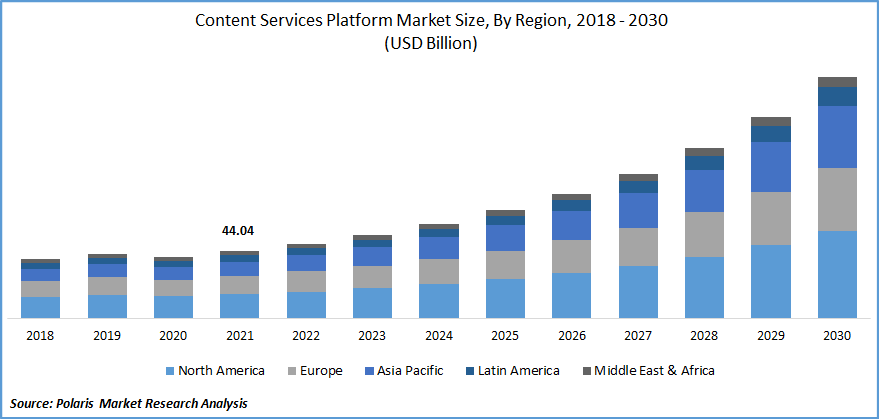
Content Services Platform Market Share, Size, Trends, Industry Analysis Report, By Deployment Type (Cloud, On-premises); By Component (Solution, Services); By Organization Size; By End-Use; By Region; Segment Forecast, 2022 - 2030
- Published Date:Oct-2022
- Pages: 115
- Format: PDF
- Report ID: PM2651
- Base Year: 2021
- Historical Data: 2018-2020
Report Outlook
The global market was valued at USD 44.04 billion in 2021 and is expected to grow at a CAGR 15.9% during the forecast period. The rise in adoption of end-to-end, cross-platform solutions and the expansion of digital content across enterprises is projected to drive the global content services platform market. In addition, increasing adoption of cloud-based solutions across all businesses may spur market growth.

Know more about this report: Request for sample pages
The proliferation of digital content across enterprises and the increasing adoption of Social, Mobile, Analytics, and Cloud (SMAC) technologies will support the expansion of the market. The content services platforms offer workflow management, data capture, indexing, and document and record management. Content services platforms are often used in end-user businesses because of their numerous functions, including contact management, vendor invoice management, and information management.
Cloud-based content services platforms allow firms to make better strategic decisions more quickly. It enables them to gain access to real-time data quickly. Cloud-based content services offer the ability to improve overall corporate operations and will have a direct impact on market growth in the future years.
The outbreak of COVID-19 influenced the global market owing to increased demand by businesses across the world for higher efficiency and performance. Implementation of lockdowns across the world resulted in greater demand for content services platforms due to an increase in work from home.
 Know more about this report: Request for sample pages
Know more about this report: Request for sample pages
Industry Dynamics
Growth Drivers
The content services platform market has bolstered many opportunities for SME players operating in the market. In addition, rise in remote working has proliferated the digital content services platforms industry as the end users were restricted to their homes. Companies are focusing on content services strategies as content services platforms offer simpler and more informative digital platforms and help in better decision-making. In addition, consumer behaviors have evolved as a result of greater connectivity via cell phones and social media. This, in turn, boosts the market growth.
Report Segmentation
The market is primarily segmented based on component, deployment type, organization size, end-user industry, and region.
|
By Component |
By Deployment Type |
By Organization Size |
By End-Use |
By Region |
|
|
|
|
|
Know more about this report: Request for sample pages
Services segment is expected to be the fastest-growing segment during the forecast period
By component, the market is segmented into solutions and services. The services segment is expected to experience high growth during the forecast period. The market for services segment is stimulated due to increased use of predictive analytics and machine learning. Many businesses attempt to become analytics-driven by gleaning insights from various data sources.
While there are a variety of analytics solutions available, one major difficulty is a lack of content analytics implementation experience, particularly when using unstructured data such as audio, text, videos, and snapshots. In addition, rising cyberattacks has encouraged companies to adopt ways to avoid data breach and secure their data. Moreover, through content service platforms, client data can be secured.
Cloud segment accounted for the largest market share
By deployment type, the market is segmented into cloud and on-premises. The cloud segment accounted for a major share of the market. The utilization of technologies such as the Internet of Things (IoT) and artificial intelligence (AI) will help drive demand.
Cloud-based content services platform enables businesses to collect extensive user information and, as a result, eliminate the need for complex processes. The market is predicted to grow significantly due to the increased availability of cloud-based solutions at affordable prices, improved data communication by different cloud platforms, increased digitization, and a rise in Big Data.
Small & medium enterprises are expected to experience high growth during the forecast period
Based on organization size, the market has been segmented into small & medium enterprises and large enterprises. The large enterprises generated significant revenue in 2021 due to the generation of large amounts of data, greater need to achieve operational efficiency, and technological advancements.
The small and medium enterprises segment is expected to experience significant growth in the coming years. There has been a rise in adoption of content services platforms owing to increasing investment in digitizing solutions, need for efficiency associated with processes, improved workflow, record management, and content analytics.
Government segment accounted for a considerable market share in 2030
By end-use, the market is categorized as BFSI, IT & Telecom, retail, healthcare, government, and others. The government segment accounted for a considerable market share. Governments at all levels are increasingly resorting to web, and mobile apps as their availability and usage have increased to enhance public communications and responsiveness.
The government market consists of national, state, provincial, and local government-controlled public sectors. Content services platforms are used by government agencies to discover best practices for acquisition planning, while commercial businesses utilize it to improve processes and efficiency.
Another factor boosting the demand for content services platforms market is the growing demand for digitization by government organizations. The government sector presents substantial development for the content services platform market due to rise in relevance of digital identity systems.
Furthermore, national security systems are likely to play a significant role in the global content services platforms market due to the rising threat of terrorism and terrorist groups' increased use of social media and other technological improvements in the communication sector.
North American region will lead the global market by 2030
The North American region is expected to account for a larger share of the content services platform market. In North America, multiple industries are investing in development of initiatives for digital transformation and adoption of emerging technologies. Acceptance of content services software improves corporate performance.
Moreover, the adoption of content services platforms depends on the business requirements, as it gives content insights and helps businesses to derive value from data. Content services platforms have seen widespread acceptance in North America because of the developed IT infrastructure in countries such as the U.S. and Canada.
Competitive Insight
The prominent market players operating in the global market include Adobe, Inc., DocuWare, Fabasoft AG, Hyland Software, Inc., IBM Corporation, Kyocera Corporation, Laserfiche, Micro Focus, Microsoft Corporation, Newgen, OpenText Corporation, Oracle Corporation, Paper Alternative Solutions Inc., and SER Group.
The major market players operating in the global market are introducing advanced solutions by leveraging technological innovation and advancements to serve the rising demand worldwide. These companies are adopting strategies such as partnerships, mergers, and collaborations to strengthen their market presence and enter new geographies.
Recent Developments
In March 2022, Adobe expanded its partner ecosystem, opening up new options for developers as well as its technology and solution partners.
In March 2022, Hyland developed content services and intelligent automation products to enhance user experience, boost automation and deliver better platform scalability.
Content Services Platform Market Report Scope
|
Report Attributes |
Details |
|
Market size value in 2022 |
USD 48.91 billion |
|
Revenue forecast in 2030 |
USD 158.80 billion |
|
CAGR |
15.9% from 2022 - 2030 |
|
Base year |
2021 |
|
Historical data |
2018 - 2020 |
|
Forecast period |
2022 - 2030 |
|
Quantitative units |
Revenue in USD billion and CAGR from 2022 to 2030 |
|
Segments Covered |
By Component, By Deployment Type, By Organization Size, By End-User Industry, By Region |
|
Regional scope |
North America, Europe, Asia Pacific, Latin America; Middle East & Africa |
|
Key Companies |
Adobe, Inc., DocuWare, Fabasoft AG, Hyland Software, Inc., IBM Corporation, Kyocera Corporation, Laserfiche, Micro Focus, Microsoft Corporation, Newgen, OpenText Corporation, Oracle Corporation, Paper Alternative Solutions Inc., and SER Group. |
